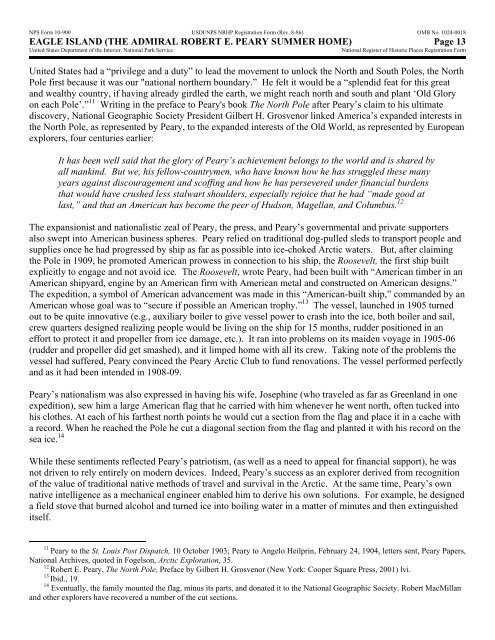Nomination - National Park Service
Nomination - National Park Service
Nomination - National Park Service
Create successful ePaper yourself
Turn your PDF publications into a flip-book with our unique Google optimized e-Paper software.
NPS Form 10-900 USDI/NPS NRHP Registration Form (Rev. 8-86) OMB No. 1024-0018<br />
EAGLE ISLAND (THE ADMIRAL ROBERT E. PEARY SUMMER HOME) Page 13<br />
United States Department of the Interior, <strong>National</strong> <strong>Park</strong> <strong>Service</strong><br />
<strong>National</strong> Register of Historic Places Registration Form<br />
United States had a “privilege and a duty” to lead the movement to unlock the North and South Poles, the North<br />
Pole first because it was our "national northern boundary.” He felt it would be a “splendid feat for this great<br />
and wealthy country, if having already girdled the earth, we might reach north and south and plant ‘Old Glory<br />
on each Pole’.” 11 Writing in the preface to Peary's book The North Pole after Peary’s claim to his ultimate<br />
discovery, <strong>National</strong> Geographic Society President Gilbert H. Grosvenor linked America’s expanded interests in<br />
the North Pole, as represented by Peary, to the expanded interests of the Old World, as represented by European<br />
explorers, four centuries earlier:<br />
It has been well said that the glory of Peary’s achievement belongs to the world and is shared by<br />
all mankind. But we, his fellow-countrymen, who have known how he has struggled these many<br />
years against discouragement and scoffing and how he has persevered under financial burdens<br />
that would have crushed less stalwart shoulders, especially rejoice that he had “made good at<br />
last,” and that an American has become the peer of Hudson, Magellan, and Columbus. 12<br />
The expansionist and nationalistic zeal of Peary, the press, and Peary’s governmental and private supporters<br />
also swept into American business spheres. Peary relied on traditional dog-pulled sleds to transport people and<br />
supplies once he had progressed by ship as far as possible into ice-choked Arctic waters. But, after claiming<br />
the Pole in 1909, he promoted American prowess in connection to his ship, the Roosevelt, the first ship built<br />
explicitly to engage and not avoid ice. The Roosevelt, wrote Peary, had been built with “American timber in an<br />
American shipyard, engine by an American firm with American metal and constructed on American designs.”<br />
The expedition, a symbol of American advancement was made in this “American-built ship,” commanded by an<br />
American whose goal was to “secure if possible an American trophy.” 13 The vessel, launched in 1905 turned<br />
out to be quite innovative (e.g., auxiliary boiler to give vessel power to crash into the ice, both boiler and sail,<br />
crew quarters designed realizing people would be living on the ship for 15 months, rudder positioned in an<br />
effort to protect it and propeller from ice damage, etc.). It ran into problems on its maiden voyage in 1905-06<br />
(rudder and propeller did get smashed), and it limped home with all its crew. Taking note of the problems the<br />
vessel had suffered, Peary convinced the Peary Arctic Club to fund renovations. The vessel performed perfectly<br />
and as it had been intended in 1908-09.<br />
Peary’s nationalism was also expressed in having his wife, Josephine (who traveled as far as Greenland in one<br />
expedition), sew him a large American flag that he carried with him whenever he went north, often tucked into<br />
his clothes. At each of his farthest north points he would cut a section from the flag and place it in a cache with<br />
a record. When he reached the Pole he cut a diagonal section from the flag and planted it with his record on the<br />
sea ice. 14<br />
While these sentiments reflected Peary’s patriotism, (as well as a need to appeal for financial support), he was<br />
not driven to rely entirely on modern devices. Indeed, Peary’s success as an explorer derived from recognition<br />
of the value of traditional native methods of travel and survival in the Arctic. At the same time, Peary’s own<br />
native intelligence as a mechanical engineer enabled him to derive his own solutions. For example, he designed<br />
a field stove that burned alcohol and turned ice into boiling water in a matter of minutes and then extinguished<br />
itself.<br />
11<br />
Peary to the St. Louis Post Dispatch, 10 October 1903; Peary to Angelo Heilprin, February 24, 1904, letters sent, Peary Papers,<br />
<strong>National</strong> Archives, quoted in Fogelson, Arctic Exploration, 35.<br />
12<br />
Robert E. Peary, The North Pole, Preface by Gilbert H. Grosvenor (New York: Cooper Square Press, 2001) lvi.<br />
13<br />
Ibid., 19.<br />
14 Eventually, the family mounted the flag, minus its parts, and donated it to the <strong>National</strong> Geographic Society. Robert MacMillan<br />
and other explorers have recovered a number of the cut sections.
















